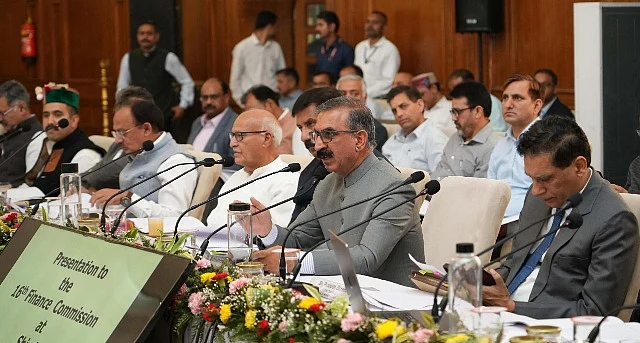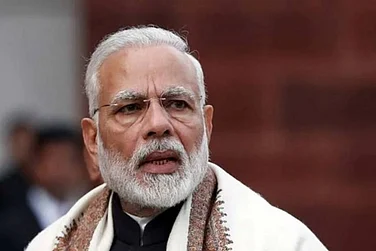Ministers’ salaries deferred for two months, payment of salaries for 2.85 lakh employees missed on the first of the month, pensioners get their dues only on the tenth day of the month, subsides cut on electricity and water for taxpayers, poll guarantee of Rs 1,500 per month to women unfulfilled, and promise to supply 300 units of free electricity rolled back.
A grim scenario on the fiscal front has set off alarm bells in resource-starved Himachal Pradesh—a state historically dependent on the Centre’s help but increasingly surviving on financial borrowings. The state’s debt burden has already surpassed its borrowing limit.
The situation now seems irredeemable for the state, where the government has alternated between the Congress and the BJP.
This time, it’s Chief Minister Sukhwinder Singh Sukhu grappling with the crisis after his party came to power after the 2022 state Assembly polls, having promised a return to the Old Pension Scheme (OPS), 300 units of free power, Rs.1,500 allowance to women, five lakh jobs to youths, Rs.680 crore start-up fund for youths, and much more.
Less than two years into power, Sukhu has already raised a loan of Rs 24,000 crore to run the state’s affairs, and plans to raise another Rs 800 crore is in the pipeline.
As per a whitepaper released by the state government, the cumulative liability of the state government has exceeded Rs 92,774 crore, including Rs 76,630 crore debt liability and Rs 10,600 crore unpaid dues on account of revised pay scales and dearness allowance. Other liabilities amounting to Rs.5,544 crore is also payable.
“Himachal Pradesh is ranked among the five most debt-ridden states in the country,” the state’s Deputy Chief Mukesh Agnihotri said while laying the white paper in the state assembly.
In the 2023-24 budget, Rs 9,048 crore has been provided for loan interest payment and another Rs 3,486 crore on loan repayments. Spending on salaries and pensions accounts for more than 40 percent of the total budget.
Congress-BJP Blame Game
Chief Minister Sukhwinder Singh Sukhu blames the previous BJP government for the financial crisis. Rs 16,262 crore was borrowed during the election year in 2022-23 to open new institutions and to spend on political functions, industrial meets and Jan Manch, he alleges.
He also blames the Centre for a massive cut in the state’s power to raise loans because of the Congress governments decision to implement OPS, non-returning of Rs.9,242 crore paid as contributions by employees to the Pension Fund Regulatory and Development Authority (PFRDA) under NPS, and for ignoring the state's plea to release Rs 9,042 crore as financial assistance under Post Disaster Need Assessment (PDNA) .
Meanwhile, the opposition BJP has accused Sukhu of playing havoc with the finances. They blame him for raising loans with the debt set to exceed Rs one lakh crore soon and for employees and pensioners not getting their dues on time for the first time in the history of the state.
“This situation is very alarming yet the Chief Minister is talking about making the state self-reliant by 2027 and financially best by 2030. How is it possible? What's the road map? Let the people know? “asks Leader of Opposition Jairam Thakur.
"Reduce The Workforce"
Avay Shukla, a retired IAS officer, said the worst thing about the incumbent government is that it did not read the writing on the wall and resorted to ‘band-aid' solutions that were not enough for the bankruptcy–like situation looming large in the state. He also blamed the state's bureaucracy for allowing the situation to reach the level where paying salaries and pensions had become an issue.
Shukla acknowledged that the Chief Minister’s efforts to reduce freebies, eliminate subsidies on electricity and water bills, and streamline PDS rations were commendable, as were steps to generate additional resources from electricity duty and liquor auctions. However, he noted that substantial stepping-up of revenue and savings were still required.
The state needs to reduce its workforce by 10 percent over the next five years, as Himachal Pradesh currently has the highest ratio of government employees relative to its population, said Shukla. Furthermore, the state should focus on leveraging tourism and horticulture as primary revenue sources, rather than investing in assets or providing incentives, said Shukla, a former Additional Chief secretary in the Himachal Pradesh government.
Burden Of OPS
Reverting to the Old Pension Scheme (OPS) may decrease the state’s pension expenditure in the short term. However, starting in 2034, when employees who joined after 2004-05 under the New Pension Scheme (NPS) begin to retire, the costs could become more pronounced. By then, the number of pensioners is expected to exceed 2.50 lakh, with the number of employees nearing three lakh.
Former Deputy Chairman of the Planning Commission Montek Singh Ahluwalia, in 2023, had spoken against reintroduction of the old pension scheme (OPS) by the Congress government, terming it an “absurd idea” and a “recipe for financial bankruptcy”. Ahluwalia, who was Planning Commission chief during the UPA government, had also said that the OPS was one of the “biggest revdis”.
Mounting Debt
The financial crisis in Himachal Pradesh has been brewing for some time amid high debt burden, and rising salary and pension bills. The practice of raising loans was started by the Virbhadra Singh government in 1993-1997, and thereafter it became an easy route to manage the cash crunch.
During the tenure of Prem Kumar Dhumal in 2007-2012, the loan liability was Rs.21,241 crore. It was during this period that the government was called upon to implement 4-9-14 Assured Career Progression Scheme (ACPS) introduced by the centre and grant revised pay scales costing Rs.6,300 crore.
The debt burden rose to Rs 46,385 crore, and thereafter to Rs 69,122 crore in 2022 as governments continued to change without any consistency in fiscal reforms and no effort on resource mobilisation. Meanwhile, there were cuts in Central grants, reduced GST presentations, and financial burden from political appointments like Chief Parliamentary Secretaries and advisors with Cabinet ranks.
“The state’s debt burden has escalated over the years, with the ratio of debt to Gross State Domestic Product (GSDP) becoming unsustainable. The state’s reliance on Central grants and loans has not been sufficient to cover its financial commitments, leading to mounting arrears in salary and pension payments,” admits a senior bureaucrat.




























